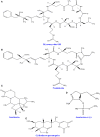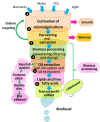Uncovering Potential Applications of Cyanobacteria and Algal Metabolites in Biology, Agriculture and Medicine: Current Status and Future Prospects
- PMID: 28487674
- PMCID: PMC5403934
- DOI: 10.3389/fmicb.2017.00515
Uncovering Potential Applications of Cyanobacteria and Algal Metabolites in Biology, Agriculture and Medicine: Current Status and Future Prospects
Abstract
Cyanobacteria and algae having complex photosynthetic systems can channelize absorbed solar energy into other forms of energy for production of food and metabolites. In addition, they are promising biocatalysts and can be used in the field of "white biotechnology" for enhancing the sustainable production of food, metabolites, and green energy sources such as biodiesel. In this review, an endeavor has been made to uncover the significance of various metabolites like phenolics, phytoene/terpenoids, phytols, sterols, free fatty acids, photoprotective compounds (MAAs, scytonemin, carotenoids, polysaccharides, halogenated compounds, etc.), phytohormones, cyanotoxins, biocides (algaecides, herbicides, and insecticides) etc. Apart from this, the importance of these metabolites as antibiotics, immunosuppressant, anticancer, antiviral, anti-inflammatory agent has also been discussed. Metabolites obtained from cyanobacteria and algae have several biotechnological, industrial, pharmaceutical, and cosmetic uses which have also been discussed in this review along with the emerging technology of their harvesting for enhancing the production of compounds like bioethanol, biofuel etc. at commercial level. In later sections, we have discussed genetically modified organisms and metabolite production from them. We have also briefly discussed the concept of bioprocessing highlighting the functioning of companies engaged in metabolites production as well as their cost effectiveness and challenges that are being addressed by these companies.
Keywords: algae; biofuel; cyanobacteria; cyanotoxins; food products; pharmaceuticals.
Figures








Similar articles
-
Biotechnological and industrial significance of cyanobacterial secondary metabolites.Biotechnol Adv. 2009 Jul-Aug;27(4):521-39. doi: 10.1016/j.biotechadv.2009.04.009. Epub 2009 Apr 22. Biotechnol Adv. 2009. PMID: 19393308 Review.
-
Nutraceutical prospects of genetically engineered cyanobacteria- technological updates and significance.World J Microbiol Biotechnol. 2024 Jul 9;40(9):263. doi: 10.1007/s11274-024-04064-1. World J Microbiol Biotechnol. 2024. PMID: 38980547 Review.
-
Microalgae as multi-functional options in modern agriculture: current trends, prospects and challenges.Biotechnol Adv. 2018 Jul-Aug;36(4):1255-1273. doi: 10.1016/j.biotechadv.2018.04.004. Epub 2018 Apr 17. Biotechnol Adv. 2018. PMID: 29673972 Review.
-
Recent advances in the bio-application of microalgae-derived biochemical metabolites and development trends of photobioreactor-based culture systems.3 Biotech. 2022 Oct;12(10):260. doi: 10.1007/s13205-022-03327-8. Epub 2022 Sep 4. 3 Biotech. 2022. PMID: 36072963 Free PMC article. Review.
-
Potential for green microalgae to produce hydrogen, pharmaceuticals and other high value products in a combined process.Crit Rev Biotechnol. 2013 Jun;33(2):172-215. doi: 10.3109/07388551.2012.681625. Epub 2012 Jul 6. Crit Rev Biotechnol. 2013. PMID: 22765907 Free PMC article. Review.
Cited by
-
Antioxidant and Cytoprotective Properties of Cyanobacteria: Potential for Biotechnological Applications.Toxins (Basel). 2020 Aug 26;12(9):548. doi: 10.3390/toxins12090548. Toxins (Basel). 2020. PMID: 32859010 Free PMC article.
-
Algae: Study of Edible and Biologically Active Fractions, Their Properties and Applications.Plants (Basel). 2022 Mar 15;11(6):780. doi: 10.3390/plants11060780. Plants (Basel). 2022. PMID: 35336662 Free PMC article. Review.
-
Algal Metabolites Can Be an Immune Booster against COVID-19 Pandemic.Antioxidants (Basel). 2022 Feb 24;11(3):452. doi: 10.3390/antiox11030452. Antioxidants (Basel). 2022. PMID: 35326102 Free PMC article. Review.
-
Natural Products from Cyanobacteria: Focus on Beneficial Activities.Mar Drugs. 2019 May 30;17(6):320. doi: 10.3390/md17060320. Mar Drugs. 2019. PMID: 31151260 Free PMC article. Review.
-
Therapeutic Potential of Natural Products in Treating Neurodegenerative Disorders and Their Future Prospects and Challenges.Molecules. 2021 Sep 2;26(17):5327. doi: 10.3390/molecules26175327. Molecules. 2021. PMID: 34500759 Free PMC article. Review.
References
-
- Abarzua S., Jakubowski S., Eckert S., Fuchs P. (1999). Biotechnological investigation for the prevention of marine biofouling II. Blue-green algae as potential producers of biogenic agents for the growth inhibition of microfouling organisms. Botanica Mar. 42, 459–465. 10.1515/BOT.1999.053 - DOI
-
- Abdo S. M., Mona H. H., Waleed M. E., Rawheya A. S. E. D., Gamila H. A. (2012). Antiviral activity of freshwater algae. J. Appl. Pharm. Sci. 2, 21–25. Available online at: http://imsear.li.mahidol.ac.th/bitstream/123456789/151107/1/japs2012v2n2...
-
- Adeyemi M. M. H. (2011). A review of secondary metabolites from plant materials for post harvest storage. Int. J. Pure Appl. Sci. Technol. 6, 94–102.
Publication types
LinkOut - more resources
Full Text Sources
Other Literature Sources
Molecular Biology Databases

